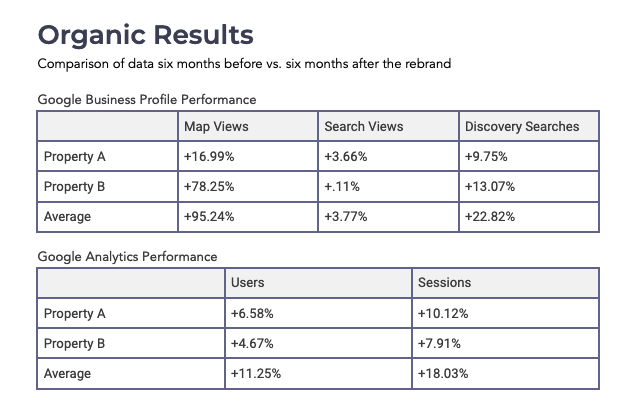Establishing a good brand is about more than just aesthetics. There is a lot that goes on behind the scenes to carefully curate a rebrand strategy to ensure that users and search engine crawlers deem your brand’s website to be trustworthy and reliable. It is only then you can achieve online visibility, rankings, and traffic.
With this in mind: How do you rebrand your website while maintaining your hard-earned organic results?
The answer is a comprehensive Search Engine Optimization (SEO) strategy. In this step-by-step guide, we will walk you through the process of preserving existing and incorporating new SEO efforts as you rebrand your apartment community.
Step One: Audit the Existing Website
A successful rebrand is all about a thorough audit and analyzing key elements such as site structure, content, keywords, and citations.
You should start by pulling a list of every URL on your site. Whether or not you plan to change your site structure, this will be helpful later in the process as you set up 301 redirects, which signals a permanent redirect from one URL to another meaning all users that use that request from an old URL will be automatically taking to the new URL on your new site.
Content is one of Google’s core ranking factors, meaning it cannot be ignored during the rebranding process. Any high-quality content — and with that, keywords — that currently exist on your site should be preserved. You can utilize a number of platforms to identify your current top keywords, along with others you plan to target post-rebrand, to strategically incorporate into your web content.
Your brand name is likely mentioned in hundreds of individual business listings across the web. Knowing how to update these citations is key as 90% of experts agree that accurate citations are crucial to local search rankings.
Step Two: Brand Name Research
When sacrificing established brand recognition, you’ll want to make your property’s new name count. There are several factors to consider.
- Is the market saturated with similarly named properties?
- Is there a nearby property or business with a poor reputation that could be mistaken for yours?
- Which potential name will draw the most traffic?
Step Three: Technical SEO
Now is the time to establish your redirects, a practice that has the potential to negatively impact your organic results. But don’t worry if you completed step one, you’ve set yourself up for success.
Here’s the gist: every page on your existing site needs to be redirected to a relevant page on your new one. Search engines use schema markup to understand the information on your site. After rebranding, it is important to update this data to include your new brand name, domain, social links, and more.
Step Four: On-Page SEO
You’ll need to update your metadata, image alt tags, and social links. If you carried content over from your old site, do a thorough review to ensure there is no mention of the old brand name.
Step Five: Off-Site SEO
Google Business Profile is a driving source of organic traffic. You should update the business name, URL, description, product links, logo, and photos that feature the old brand name.
Digible can help update your citations by submitting your business information to the correct aggregators.
Step Six: Review and Monitor Metrics
Has the rebrand impacted organic traffic and rankings?
As always with SEO, you will not see results overnight. In the first month or two you might even see a slight decrease in traffic and rankings — that is normal. Search engines need time to index changes. You should eventually see these metrics level off and begin to increase. It’s important to continue monitoring performance after launch to make any necessary strategy shifts.
Property A:
- Rebranded in fall 2022
- Poor Reputation
- New Ownership
Property B:
- Rebranded in winter 2022
- Poor Reputation
- New Ownership

Increased Map & Search Views
- A proper rebrand can prevent the number of people who view your business profile from decreasing. We Digible’s test properties saw a combined 95.24% increase in map views and a 3.77% increase in search views for several properties in various regions.
-
- This is significant because both properties rebranded during the apartment industry’s off-season (November – January). Slight decreases in organic results can often be expected during this time. Our properties saw an average increase of GBP views over the 6-month period (winter) following the rebrand launch.
Increased Discovery Search
- A discovery search is when a customer searches for a category, product, or service that you offer, and your profile appears. Think “apartments in Denver” or “Chicago apartments for rent”. Our properties were more likely to be discovered post-rebrand.
Increased Traffic
- Users were more likely to click through to the websites, creating opportunities for lead generation.
Next Step: Hello SEO Rebrand
Rebranding for your property is an optimal strategic move in the multifamily industry for a variety of reasons. Whether you are aiming to refresh a newly acquired property, rid an existing property’s bad reputation, or elevate your brand to complement a remodel, a well-executed rebrand can do the trick. With these six steps, you can preserve the SEO equity of your website. Or, Digible can help!
The Rebrand Package we provide encompasses a thorough rebranding plan, executed within a 30-day timeframe. This package aims to uphold your existing organic outcomes while actively striving to amplify your organic footprint by ensuring the continuity of your SEO endeavors.
 $100K Lease-Stakes
$100K Lease-Stakes 








